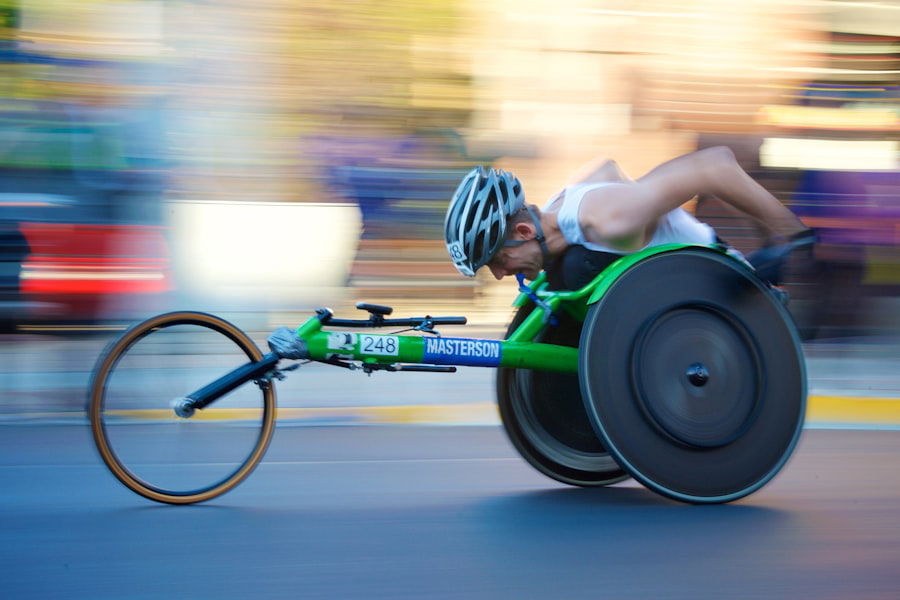The 2024 Paralympic Games will feature wheelchair racing as one of its prominent events. Wheelchair racing is a competitive sport that involves athletes using specially designed racing wheelchairs to compete in track events. The sport has gained popularity due to its fast-paced nature and the exceptional skill required by athletes.
Wheelchair racing events at the Paralympics typically include various distances, ranging from 100 meters to marathon length. Athletes compete in different classifications based on their level of physical function, ensuring fair competition among participants with similar abilities. The 2024 Paralympics in Paris will bring together wheelchair racers from numerous countries, showcasing the global appeal and competitiveness of the sport.
These athletes undergo rigorous training regimens to develop their upper body strength, endurance, and racing techniques. Wheelchair racing has evolved significantly since its introduction to the Paralympic program, with technological advancements in wheelchair design contributing to improved performance and faster race times. The sport continues to attract new participants and spectators, highlighting the growing interest in adaptive sports and the achievements of athletes with disabilities.
The Paralympic Games serve as a platform to promote inclusivity and raise awareness about adaptive sports. Wheelchair racing, along with other Paralympic events, demonstrates the athletic capabilities of individuals with physical impairments and challenges societal perceptions of disability.
Key Takeaways
- Wheelchair racing is a thrilling and competitive sport that is an integral part of the Paralympic Games, showcasing the incredible athleticism and determination of para-athletes.
- The history of wheelchair racing in the Paralympics dates back to the 1960s, and has since evolved to become a highly anticipated and respected event in the games.
- Notable athletes to watch in wheelchair racing at the 2024 Paralympics include Tatyana McFadden, Marcel Hug, and Daniel Romanchuk, who have consistently dominated the sport with their exceptional skills and achievements.
- The 2024 Paralympics will feature a variety of wheelchair racing events, including sprints, middle-distance races, and marathons, providing a platform for athletes with different strengths and abilities to compete.
- Equipment and technology play a crucial role in wheelchair racing, with specially designed racing wheelchairs and advanced training tools contributing to the success and performance of athletes in the sport.
History and Evolution of Wheelchair Racing in the Paralympics
The history of wheelchair racing in the Paralympics dates back to the 1960s when the sport was first introduced as a demonstration event at the Tokyo Paralympic Games in 1964. Since then, wheelchair racing has evolved into one of the most popular and widely recognized events at the Paralympics, captivating audiences with its speed, agility, and competitive spirit. Over the years, the sport has seen significant advancements in technology, training methods, and athlete participation, leading to a higher level of competition and athleticism.
The evolution of wheelchair racing in the Paralympics has been marked by the remarkable achievements of athletes who have pushed the boundaries of what is possible in the sport. From breaking world records to winning multiple gold medals, wheelchair racers have continued to inspire and awe audiences with their incredible performances. The inclusion of wheelchair racing in the Paralympics has also played a crucial role in promoting inclusivity and diversity in sports, providing athletes with disabilities a platform to showcase their talents and compete at the highest level.
As the sport continues to grow in popularity and recognition, the history and evolution of wheelchair racing in the Paralympics serve as a testament to the resilience, determination, and extraordinary abilities of its athletes.
Notable Athletes to Watch in Wheelchair Racing at the 2024 Paralympics

The 2024 Paralympic Games will feature a stellar lineup of wheelchair racers who are poised to make a significant impact on the sport. Among the notable athletes to watch is Tatyana McFadden, a decorated wheelchair racer with an impressive track record of success at the Paralympic Games. McFadden, who has won numerous gold medals and set multiple world records, is known for her exceptional speed and endurance on the track.
Her remarkable achievements and unwavering determination make her a top contender in wheelchair racing events at the 2024 Paralympics. Another athlete to watch is Marcel Hug, a Swiss wheelchair racer who has established himself as one of the leading competitors in the sport. Hug’s exceptional talent and competitive drive have earned him numerous accolades, including multiple gold medals at the Paralympic Games.
With his unparalleled skill and determination, Hug is expected to deliver outstanding performances in wheelchair racing events at the 2024 Paralympics. These are just a few of the many remarkable athletes who will be competing in wheelchair racing at the 2024 Paralympic Games, each bringing their own unique talents and inspiring stories to the world stage.
The Different Wheelchair Racing Events at the 2024 Paralympics
The 2024 Paralympic Games will feature a variety of wheelchair racing events that showcase different distances and racing styles. The events include sprints, middle-distance races, and long-distance marathons, each requiring a unique combination of speed, endurance, and tactical skill. The sprint events, such as the 100m and 200m races, are known for their explosive starts and high-speed sprints, testing athletes’ raw speed and acceleration.
The middle-distance races, including the 400m and 800m events, require a balance of speed and endurance, challenging athletes to maintain a fast pace over longer distances. Finally, the long-distance marathons, such as the 1500m and marathon races, demand exceptional endurance and strategic race tactics as athletes navigate longer distances on the track. Each wheelchair racing event at the 2024 Paralympics presents its own set of challenges and opportunities for athletes to showcase their skills and compete at the highest level.
From lightning-fast sprints to grueling marathons, these events will undoubtedly provide spectators with thrilling displays of athleticism and sportsmanship. As athletes from around the world come together to compete in these diverse events, the wheelchair racing competitions at the 2024 Paralympics are sure to captivate audiences with their intensity and excitement.
Equipment and Technology in Wheelchair Racing
Wheelchair racing has seen significant advancements in equipment and technology that have revolutionized the sport and enhanced athletes’ performance on the track. Modern racing wheelchairs are designed with lightweight materials, aerodynamic frames, and specialized wheels that maximize speed and efficiency. These high-performance wheelchairs are custom-built to fit each athlete’s unique specifications, providing optimal comfort and control during races.
In addition to advanced racing wheelchairs, athletes also use specialized gloves and racing suits that reduce air resistance and improve aerodynamics, further enhancing their performance on the track. The use of cutting-edge technology has also played a crucial role in optimizing training methods and race strategies for wheelchair racers. Athletes utilize sports science techniques such as biomechanical analysis, performance tracking systems, and customized training programs to improve their speed, endurance, and overall race performance.
Furthermore, advancements in sports nutrition and recovery methods have enabled athletes to maintain peak physical condition and maximize their training gains. The integration of equipment and technology in wheelchair racing has not only elevated the level of competition but also empowered athletes to push their limits and achieve new heights of success in the sport.
Training and Preparation for Wheelchair Racing at the 2024 Paralympics

The road to competing in wheelchair racing at the 2024 Paralympics requires rigorous training, unwavering dedication, and meticulous preparation. Athletes undergo intensive training regimens that focus on developing speed, strength, endurance, and race tactics specific to wheelchair racing events. Training sessions include a combination of track workouts, strength training, cardiovascular conditioning, and technique drills aimed at improving athletes’ overall performance on the track.
In addition to physical training, athletes also receive comprehensive support from sports psychologists, nutritionists, physiotherapists, and coaches who play a crucial role in optimizing their mental and physical well-being. Mental preparation is equally important as physical training, as athletes must develop mental resilience, focus, and race strategies to perform at their best under pressure. Furthermore, athletes engage in race simulations, strategy sessions, and video analysis to fine-tune their race tactics and prepare for various race scenarios they may encounter during competition.
The preparation for wheelchair racing at the 2024 Paralympics demands an unwavering commitment from athletes who dedicate countless hours to perfecting their craft and achieving peak performance on race day. With meticulous training and preparation, these remarkable athletes are ready to showcase their extraordinary talents on the world stage.
The Impact and Importance of Wheelchair Racing in the Paralympic Movement
Wheelchair racing holds immense significance within the Paralympic movement as it embodies the core values of inclusivity, diversity, and athletic excellence. The sport provides athletes with disabilities a platform to compete at the highest level while inspiring millions around the world with their remarkable performances. Wheelchair racing has played a pivotal role in breaking down barriers and challenging stereotypes about disability in sports, paving the way for greater acceptance and recognition of athletes with disabilities.
The impact of wheelchair racing extends beyond athletic achievement as it serves as a powerful symbol of determination, resilience, and triumph over adversity. The sport has inspired countless individuals with disabilities to pursue their athletic dreams while promoting greater awareness and understanding of disability rights and inclusion. Furthermore, wheelchair racing has contributed to shifting societal attitudes towards disability by showcasing the extraordinary abilities and achievements of its athletes.
As we look ahead to the 2024 Paralympic Games in Paris, wheelchair racing will continue to play a central role in promoting diversity, inclusivity, and athletic excellence within the global sporting community. The impact of this exhilarating sport extends far beyond competition as it serves as a beacon of hope and inspiration for people of all abilities around the world. With its profound impact on society and its unwavering commitment to inclusivity, wheelchair racing remains an integral part of the Paralympic movement.
If you’re interested in learning more about the business side of sports, you might want to check out this article on why betting sites are some of the most successful businesses. It provides insight into the lucrative world of sports betting and how it has become a thriving industry. Understanding the business aspects of sports can provide a different perspective on events like wheelchair racing at the 2024 Paralympics.
FAQs
What is wheelchair racing at the Paralympics?
Wheelchair racing is a Paralympic sport where athletes with physical disabilities compete in racing wheelchairs. The sport is a part of the Paralympic Games and includes various track and road racing events.
When and where will the 2024 Paralympics take place?
The 2024 Paralympic Games are scheduled to take place in Paris, France from August 28 to September 8, 2024.
How is wheelchair racing at the Paralympics different from able-bodied racing?
Wheelchair racing at the Paralympics is specifically designed for athletes with physical disabilities who use racing wheelchairs. The events and rules are adapted to accommodate the needs and abilities of the athletes.
What are the different events in wheelchair racing at the Paralympics?
The Paralympic wheelchair racing events include sprints, middle-distance races, marathons, and relay races. Athletes compete in various categories based on their level of disability.
Who is eligible to compete in wheelchair racing at the Paralympics?
Athletes with physical disabilities such as spinal cord injuries, cerebral palsy, and lower limb amputations are eligible to compete in wheelchair racing at the Paralympics. They must meet the eligibility criteria set by the International Paralympic Committee (IPC).
How can I watch wheelchair racing at the 2024 Paralympics?
The Paralympic Games are broadcasted globally, and viewers can watch wheelchair racing events through official broadcasters, online streaming platforms, and Paralympic Games websites. Check local listings for specific broadcast details.
